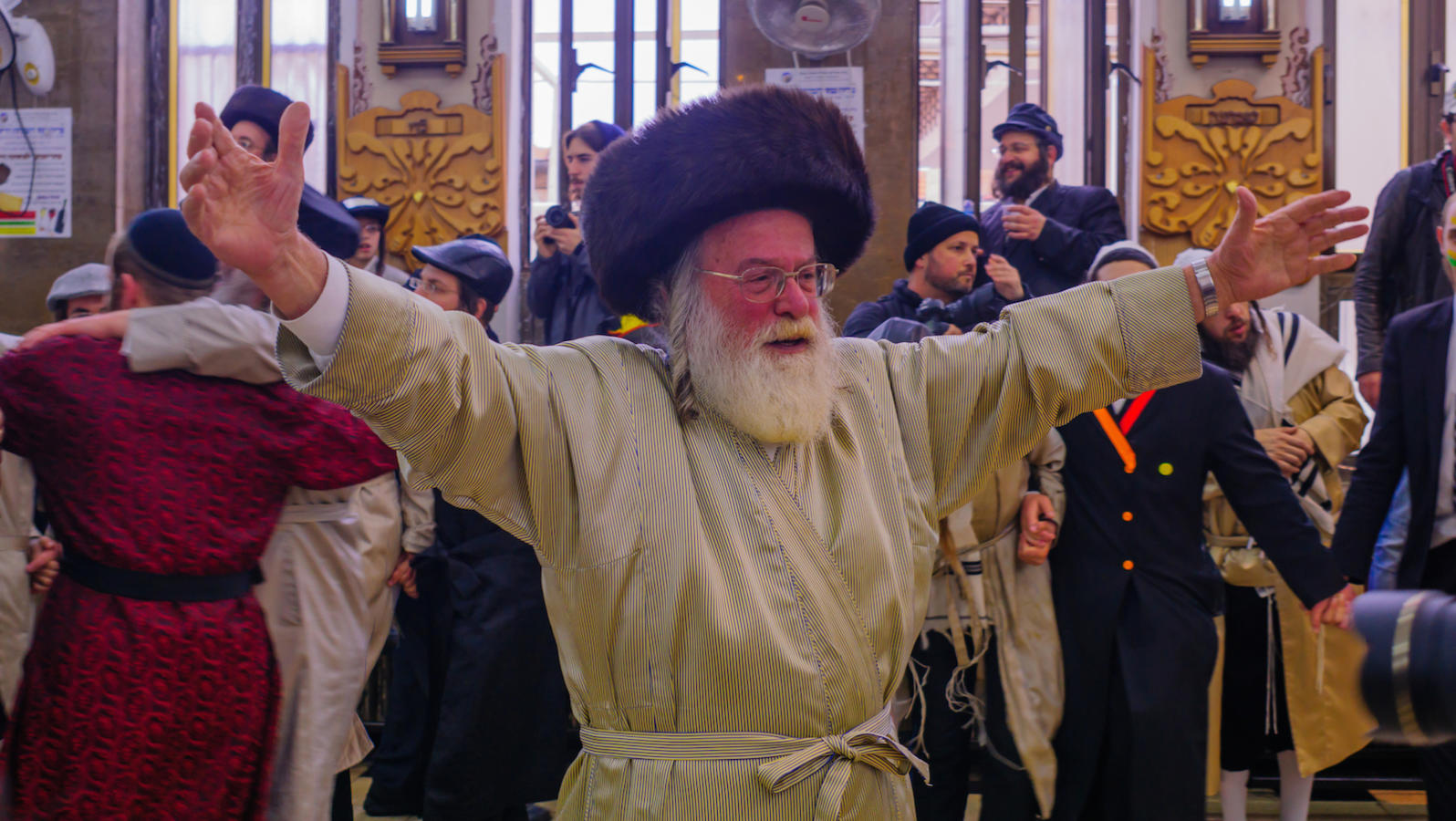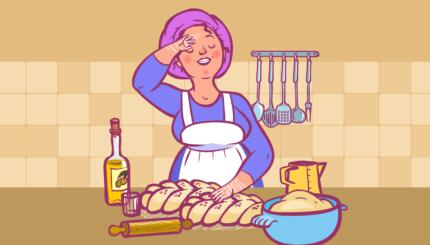“There are gates in heaven that cannot be opened except by melody and song.”—Attributed to Rabbi Shneur Zalman of Liady, founder of Chabad
From the time of its emergence in the 18th century, the Hasidic movement turned to music and dance as powerful forms of Jewish religious expression. One result was the Hasidic nigun (Hebrew for “melody”; plural nigunim), a new genre of Jewish vocal music. Often described as a mystical musical prayer or a spiritual language beyond words, the Hasidic nigun is a fundamental part of all Ashkenazi culture and is, in the words of one Hasidic master, “the pen of the soul.”
Features and Style
Musically speaking, Hasidic nigunim vary enormously in style, form and feeling. Some are slow and meditative, others fast and jubilant. Nevertheless, they generally share certain basic features: They are songs formed of multiple melodic phrases, typically sung without instrumental accompaniment and without words. This last feature, while not found in every Hasidic nigun, is one of the genre’s most distinguishing characteristics. In place of words, repeated “nonsense” syllables (such as bam-bam-bam and doi-doi-doi) are used. Nigunim are also performed in a distinctive expressive vocal style with dramatic inflections similar to cantorial music referred to by the Yiddish words krekhts (lit. moan, sigh, or sob) and kneytsh (lit. pinch).
The unique form and features of Hasidic nigunim reflect the creative and radical nature of Hasidic theology. To be sure, the connection between music and Jewish prayer was not a wholly Hasidic invention. In fact, music had always played a central role in Jewish religious life, a fact to which both ancient biblical texts such as the Book of Psalms and medieval liturgical songs (piyyutim) testify.
With your help, My Jewish Learning can provide endless opportunities for learning, connection and discovery.
Likewise, medieval Jewish mystics developed complex ideas about the theological and even magical power of music in the universe. However, the rabbis took a decidedly cautious, sometimes even negative attitude towards music. Out of concerns about piety and the role of music in gentile religious and cultural traditions, they generally discouraged the use of instrumental music in the synagogue and banned it altogether on the Sabbath and holidays. Most crucially, they insisted that text mattered more than melody. Thus in traditional liturgy and medieval religious poetry, individual melodies were frequently changed but the Hebrew and Aramaic texts were considered sacred and unalterable.
A Great Spiritual Power
Musically speaking, the revolution of the 18th-century Hasidic movement was to elevate music to a symbolic place above sacred text. Now, melodies themselves were not only acceptable but even in some cases more important than words. According to Hasidic tradition, this idea began with the founder of Hasidism, Rabbi Israel Baal Shem Tov (or the Besht, 1698-1750). The Baal Shem Tov is credited with emphasizing the importance of vocal music as a form of personal confession and spiritual expression. He taught that song is an even greater form of spiritual expression than traditional prayer and that the Hasidic nigun was a musical path to God that transcended the limitations of language itself. There remain many nigunim attributed to the Baal Shem Tov , including “Dem Rebns Nigun.”
This same reverence for the nigun and belief in its great spiritual power continued down through the generations of Hasidic rabbinic dynasties. The centrality of this is expressed in many sayings, such as Rabbi Nachman of Breslov‘s “Music originates from the prophetic spirit, and has the power to elevate one to prophetic inspiration” and “Song is the soul of the universe.”
Chabad Nigunim
One of the most famous Hasidic composers was Rabbi Shneur Zalman of Liady (1745-1812), the founder of the Chabad Lubavitch movement. For this first Lubavitcher Rebbe, melody was an outpouring from the individual human soul; words only interrupted the stream of emotions. Furthermore, melodies with texts were limited in time because they only lasted as long as the words. “The song of the souls,” on the other hand, “consist of tones only, dismantled of words.” As such, they reached onto the truly cosmic level of the universe.
Shneur Zalman is credited with the composition of one of the most famous Hasidic nigunim, the “Nigun of the Four Gates” (Nigun arba bavos), said to have been written during his imprisonment by the czarist government in St. Petersburg in 1798. This nigun has four sections, which build in musical intensity. They have been interpreted in a variety of ways. One common interpretation is that they represent a human process of soul expression leading to spiritual awakening, receiving the divine, cleaving to God, and then the soul’s separation from the body and ascent to the heavens. Another interpretation is that the four gates represent the four mystical spiritual realms of asiyah (activation), briah (creation), yetzirah (formation), and atzilut (divine emanation). Still another view holds that the four sections symbolize four stages of God’s creation of the universe: the physical world, the natural world (plants and animals), humankind, and the heavens.
Types of Nigunim
Later Hasidic rebbes continued to ascribe both mystical, magical power to nigunim and extolled the more basic, if no less powerful, effects of music on human psychology. Over time, different kinds of nigunim developed amongst various Hasidic communities and in the larger East European Jewish world. There are many different kinds of nigunim, associated with Talmud study, prayers and other aspects of traditional Jewish life. Roughly speaking, however, the three main kinds of Hasidic nigunim are deveykut nigunim, dance tunes and tisch nigunim:
1. Deveykut (Dveykes) Nigunim
These are usually slow-tempo melodies in free rhythm (non-metric) or changing meter, with a reflective mood. Their name derives from the biblical passage in Deuteronomy 13:4 (“And cleave unto Him”) that refers to the individual’s attempt to commune with God. They are usually performed by individuals.
2. Dance Tunes
Dance tunes are simpler, faster, and more rhythmic (and metrical) designed to be sung by a group during dancing. They are usually performed in unison (without harmony).
3. Tisch Nigunim (Table Tunes)
Tisch nigunim or “table” tunes are slower and more complex, often sung at Sabbath or holiday meals or in the presence of a Hasidic rebbe.
Origins and Sources
Where do the melodies of Hasidic nigunim come from? While many tunes are ascribed to specific musicians or famous rebbes, other were adopted from a diverse array of sources, including traditional Jewish prayer, modes to Cossack dances, Polish military marches, East European folk songs, Near Eastern dance tunes and even Central European waltzes. The use of secular or non-Jewish melodies for nigunim was not considered a problem for Hasidic Jews. On the contrary, Hasidic thought contains a notion of tikkun (literally, “fixing”), whereby non-Jewish or secular melodies can be spiritually redeemed and restored to their religious state by being sung as nigunim, either with new religious lyrics or without words altogether.
A famous example of this tikkun is the Hungarian nigun, “Gules, gules.” According to tradition, the Kalever Tzaddik, Isaac Eizik (Toib) of Kalev (1744-1821), was once walking in the Ukrainian forest when he heard a pastoral shepherd singing a love song in Ukrainian. The Hasidic Jew was captivated by the song, whose lyrics spoke of the shepherd’s longing for his love, separated from him by the vast forest. The Hasidic rebbe took the song and translated the lyrics into Yiddish, replacing the lyrics’ description of secular love with a description of his soul’s longing for the shechinah, the mystical divine presence (of God). He then asked the shepherd to sing the song, but the young man found he had forgotten it. Whereupon the Hasid exclaimed, “”I have purified the nigun and returned it to its holy sources!”
Later Developments
In modern times, this process of musical borrowing and exchange worked in many unpredictable directions. Hasidic nigunim found their way into Zionist folk and popular music (see, “Hava Nagila“), Yiddish theater and European classical music.
Perhaps the best evocation of the modern transformations of Hasidic nigunim comes in a famous short story by the Yiddish writer Y.L. Peretz. In this work, called “A gilgul fun a nigun” (“The Transmigration of a Melody”), the author describes the tale of a nigun that wanders from town to town in Eastern Europe as various people hear it and borrow it temporarily. After beginning its life as a wedding melody composed for a Hasidic rebbe, it goes on to become a Jewish memorial prayer in another shtetl, then moves via Kiev to the Yiddish theater in Warsaw, only to end up being played as a poor organ-grinder’s tune in the circus. The nigun’s wanderings continues from house to house, person to person, town to town, and, eventually, back to the Hasidic rebbe. But the melody’s migration is not yet done. At the tale’s end, it departs with one of its bearers to a new destination: America.
Peretz’s story aptly conveys the fate of Hasidic nigunim in the modern world. They continue to live multiple, often unpredictable lives both in present-day Hasidic communities and other parts of the Jewish world.
Hasid
Pronounced: KHAH-seed, Origin: Hebrew, a Hasidic Jew, a follower of Hasidic Judaism, a stream within ultra-Orthodox Judaism that grew out of an 18th-century mystical revival.
Hasidic
Pronounced: khah-SID-ik, Origin: Hebrew, a stream within ultra-Orthodox Judaism that grew out of an 18th-century mystical revival movement.
nigun
Pronounced: nee-GOON (oo as in boot), Origin: Hebrew, literally "melody," it is used to describe the mystical prayers or songs of Hasidic origin.
Talmud
Pronounced: TALL-mud, Origin: Hebrew, the set of teachings and commentaries on the Torah that form the basis for Jewish law. Comprised of the Mishnah and the Gemara, it contains the opinions of thousands of rabbis from different periods in Jewish history.
shtetl
Pronounced: shTETTull, Origin: Yiddish, a small town or village with a large Jewish population existing in Eastern or Central Europe in the 19th and early-to-mid 20th century.


